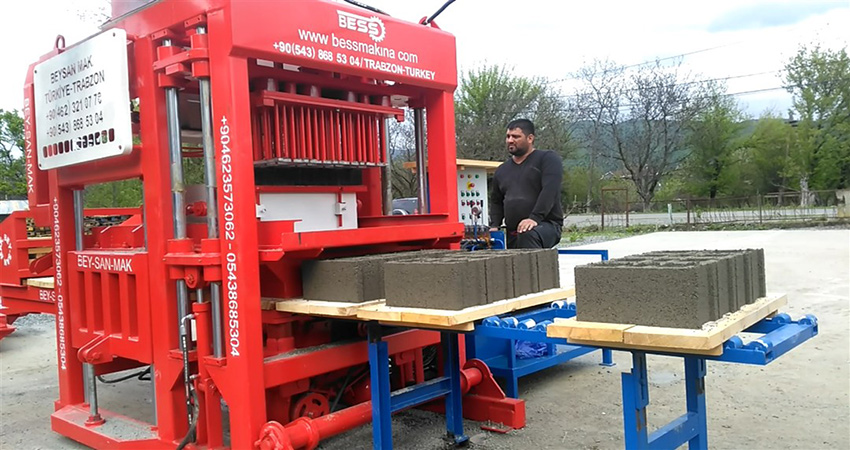Comprehensive block-making machine tutorial. This includes the working methods of manual and vehicle block-making machines up to the final stage.

Block-Making Tutorial
Setting up a block-making workshop is not just about purchasing equipment. From choosing a suitable plot in an appropriate area to obtaining necessary permits, everything must be considered before starting. One important step is learning block-making. Training before starting work is crucial. The best way to learn is through professional block-making workshops. You can gain experience by working for some time in such workshops. Gaining hands-on experience can help you master the techniques, learn to work with different machines, identify the best equipment, and understand the most efficient methods for making concrete blocks.

Getting Started with the Block-Making Machine
Manual Block-Making Machine Instructions:
Manual block-making machines, as the name implies, are operated entirely manually. Using this machine requires one or two operators to guide the mold upward using a handle and lock it into place. Afterward, the operator fills the mold with raw materials using a block-making wheelbarrow and activates the vibrator installed on the machine by pressing a button.
The vibrator applies force to the mold, ensuring the material is fully compacted and evenly distributed. For purchasing and price inquiries regarding fully automatic block-making machines, you can contact Beton Sarmad experts for further information.
Block Production Using Vehicle Block-Making Machines:
To use vehicle block-making machines, first fill the machine's tray with concrete using a wheelbarrow, then transfer it smoothly with a leveler. After leveling the mold, strike the handle twice to compact the concrete. Vibrate the mold for 2-4 seconds, turn off the vibration, and lift the mold lever, leaving the block on the ground.

Final Stage of Using the Block-Making Machine
After these steps, the material is ready for compression and shaping. Unlock the mold to compress the material inside. Start the motor to shape the concrete blocks. Afterward, the blocks are ready to be moved for drying. Move the machine forward and repeat the steps to produce more blocks. Once the blocks dry, they are ready for use.
How to Use an Automatic Block-Making Machine
One of the main advantages of automatic block-making machines is the lack of operator dependency. This stationary machine performs all production stages automatically. It offers features like speed control, no heavy physical labor, and the ability to produce various block types. To use this machine, mix cement, sand, and other materials as required, fill the molds, and lower the press to compact the materials. Then raise the lever to release the block. Ensure the press remains down and the vibrator stays active during the process for optimal results. The machine is easy to use and can be upgraded with additional software for advanced operations.
Adjusting the Block-Making Machine's Vibration
Adjusting the machine's vibration is critical for the quality and strength of the produced blocks. Follow these steps for proper adjustment:
Inspect the Vibrator: Ensure the vibrator is functional and free of defects. Any malfunction can impact performance.
Set Vibration Speed: Adjust the speed to ensure uniform and appropriate vibration. Most machines have settings for this purpose.
Adjust Vibrator Weights: Some machines allow weight adjustments to balance vibration intensity. Ensure proper weight distribution across the mold.
Test the Vibration: Conduct a practical test by filling the mold and activating the machine. Ensure the vibration is smooth and consistent.
Check Block Quality: After producing a few blocks, inspect their quality. Adjust the vibration if blocks have voids or cracks.
Set Vibration Duration: The vibration duration should be sufficient to compact materials completely without weakening the blocks.
Maintain the Machine: Regularly clean and maintain the vibrator to ensure optimal performance.

Using Ceiling Block-Making Machines
Ceiling block-making machines are essential tools in construction for producing concrete blocks. They are commonly used in large-scale residential projects to create blocks with specific dimensions and quality. To start, familiarize yourself with the components of the machine, including material hoppers, transfer systems, block molds, and hydraulic mechanisms.
Prepare materials such as cement, sand, and aggregates in proper proportions based on block requirements. Transfer the mix to molds using the machine's system. Adjust pressure and injection timing for optimal block quality. Allow sufficient curing time before removing the blocks from molds. Proper handling during these stages ensures high-quality results.
Using Fully Automatic Block-Making Machines
Fully automatic block-making machines are among the most advanced, reducing manual labor while enhancing production efficiency and quality. These machines often include computerized control systems for precise settings. Begin by preparing materials according to specifications and load them into the machine. The machine automates weighing, mixing, and transferring materials to molds.
Features like customizable dimensions and automated block transfer systems improve productivity and safety. Proper parameter settings are essential for maintaining high-quality output. Detailed familiarity with the machine's instructions is necessary for effective use.
Using Semi-Automatic Block-Making Machines
Start by preparing materials and following the machine's guidelines for proper ratios. Mix the materials manually or with a semi-automatic mixer, then transfer the mix to molds. Precision during this step ensures accurate block shapes and sizes.
Semi-automatic machines require manual adjustments during production. After filling molds, place the blocks in an appropriate area for curing. Final block quality depends on attention to detail throughout the production process.

